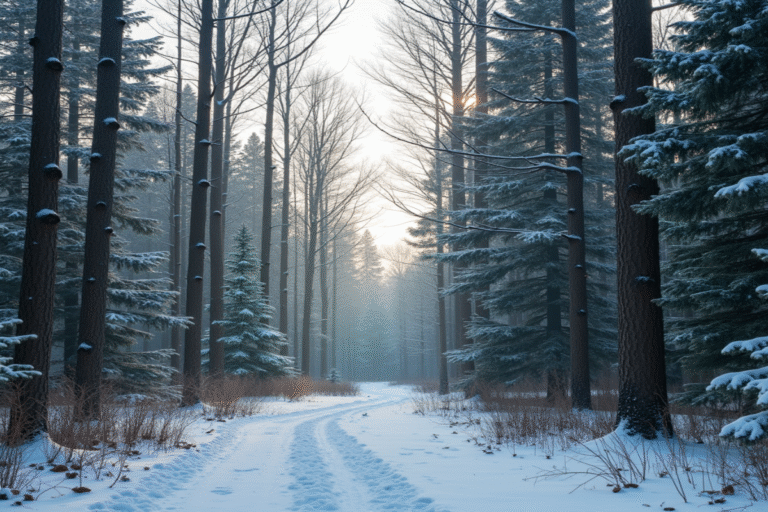When winter’s icy grip takes hold and temperatures plunge below freezing, humans bundle up in layers or retreat indoors to heated sanctuaries. But trees? They stand tall and exposed, enduring months of freezing conditions without the luxury of movement or shelter. What’s even more remarkable is that trees are roughly 50% water—the very substance that expands when frozen, potentially rupturing living cells. So how do these silent giants survive winter’s brutal assault without becoming tree-shaped ice sculptures?
The deadly threat of ice crystals
To appreciate trees’ winter survival genius, we first need to understand the mortal danger freezing poses. When water freezes inside a living cell, ice crystals form, expanding and puncturing delicate cell membranes—which destroys the cell from within. For mammals, this would mean certain death. Yet trees have evolved several sophisticated mechanisms to prevent this fatal crystallization.
Dr. Paul Schaberg, a plant physiologist with the USDA Forest Service, explains: Trees have essentially developed their own biological antifreeze systems through millions of years of evolution. It’s one of nature’s most impressive adaptations.
Preparing for the cold: cellular transformations
As autumn approaches and daylight hours shorten, trees begin a remarkable process called “cold hardening.” This process involves:
- Dehydration: Trees strategically remove water from their cells and store it in spaces between cells where freezing causes less damage.
- Sugar concentration: They convert starches to sugars within cells, creating a natural antifreeze that lowers the freezing point of their cellular fluid—similar to how salt prevents roads from icing.
- Membrane modifications: Cell membranes become more flexible and permeable, allowing water to move out more easily and preventing rupture.
- Antifreeze proteins: Some species produce specialized proteins that bind to developing ice crystals, preventing them from growing large enough to damage cells.
The dormancy strategy: slowing down to survive
Trees enter a state of dormancy during winter—essentially the plant equivalent of hibernation. Metabolic processes slow dramatically, growth ceases, and energy consumption drops to minimal levels. This state is triggered by the shortening days of autumn rather than dropping temperatures, ensuring trees begin preparations before the first freeze arrives.
In deciduous trees, the most visible winter adaptation is leaf drop. By shedding leaves, trees eliminate the structures most vulnerable to freeze damage and reduce water loss through transpiration. The abscission process that separates leaf from branch is a complex sequence of hormones and specialized cells that forms a protective layer over the exposure point.
A single mature oak tree may drop between 200,000 and 500,000 leaves each autumn—all part of its winter survival strategy.
Evergreen innovation: different but equally effective
Coniferous evergreens take a different approach. Instead of dropping their needle-like leaves, these trees have evolved special adaptations:
- Their needles have a small surface area and a waxy coating that reduces water loss
- The dark green color absorbs more sunlight and heat
- Their flexible branches shed snow easily, preventing limb breakage
- Many produce extra resin, which acts as natural insulation
Perhaps most fascinating is that pine needles contain highly specialized cells that can supercool to temperatures as low as -40°F (-40°C) without freezing solid, thanks to their high sugar concentration and antifreeze proteins.
Bark: nature’s insulating blanket
A tree’s bark serves as crucial thermal protection. The corky outer layers act as insulation, helping maintain more stable temperatures within. Some species, like the paper birch, have air-trapping layers that provide extra insulation, similar to how a down jacket keeps us warm by trapping air pockets.
The thickness and composition of bark vary dramatically between species, partly explaining why some trees can survive in colder climates than others. Redwoods have fibrous bark up to 12 inches thick, while white pines possess fire-resistant layered bark with unique resin channels that offer extra cold protection.
Underground resilience
While we focus on the visible parts of trees, much of their winter survival strategy unfolds underground. Soil provides natural insulation, keeping temperatures higher than the air above. Root systems store vital energy reserves as carbohydrates that fuel minimal winter metabolism and the surge of growth in spring.
Snow cover, when present, actually benefits trees by providing an additional insulating layer that stabilizes soil temperatures. A thick blanket of snow can keep soil at or near freezing even when air temperatures drop far below zero—one reason sudden cold snaps without snow cover can be especially harmful.
Climate change: disrupting ancient rhythms
These finely tuned winter survival mechanisms evolved over millions of years with relatively stable seasonal patterns. Today’s rapidly changing climate presents new challenges. Unseasonably warm spells may trigger premature deacclimation, leaving trees vulnerable if temperatures suddenly plunge again. Meanwhile, some regions experience deeper cold events due to disrupted weather patterns like polar vortex shifts.
Research has shown that trees with the most precise timing mechanisms—those that track both photoperiod and accumulated cold exposure—may navigate climate disruption most successfully, while species with simpler triggers face greater risk.
Nature’s freeze-resistant marvels
The next time you walk through a winter landscape, take a moment to appreciate the silent chemical and physical battles trees are waging against the cold. Their intricate antifreeze systems, cellular changes, and structural adaptations represent one of nature’s most impressive feats—all happening without a sound or visible movement.
From converting starches to sugars, to producing special proteins, to restructuring their very cells, trees show that sometimes standing still and adapting is smarter than fleeing. In their patient resistance to winter’s extremes, trees offer powerful lessons in resilience and the extraordinary adaptability of life.





